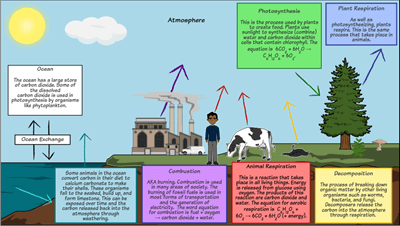Activity Overview
In this activity, students will look at the different processes in the carbon cycle in more detail. They will create a spider map that describes each process and includes the word equation of each chemical reaction. Stretch your students even further by asking them to include the symbol equation for each reaction as well.
Combustion
Combustion is more commonly known as burning. Humans use this chemical reaction to generate electricity and power the vehicles we use to move around. It release carbon into the atmosphere in the form of carbon dioxide. The equation for this reaction is fuel + oxygen → carbon dioxide + water.
Photosynthesis
This is a process that takes place in many autotrophic living things, such as plants and algae. In plants, it takes place mainly in leaves, but also occurs in other green parts of the plant. It is a chemical reaction the uses sunlight to make glucose from water and carbon dioxide. The word equation for photosynthesis is water + carbon dioxide → glucose + oxygen. The symbol equation for photosynthesis is 6CO2 + 6H2O → C6H12O6 + 6O2.
Cellular Respiration
This is a process that takes place in all living things. Organisms use it to release energy from glucose. It is a chemical reaction that puts carbon into the atmosphere in the form of carbon dioxide. The word equation for the aerobic reaction is glucose + oxygen → carbon dioxide + water. The symbol equation for aerobic respiration is C6H12O6 + 6O2 → 6CO2 + 6H2O(+ energy).
Template and Class Instructions
(These instructions are completely customizable. After clicking "Copy Activity", update the instructions on the Edit Tab of the assignment.)
Student Instructions
Create a spider map that identifies and explains the different processes in the carbon cycle.
- Click "Start Assignment".
- Identify each process of the carbon cycle and type each term in the title boxes.
- Create a visualization or representation in the cell.
- In the description boxes, write a short description to help describe the process.
- In a Textable, write the word equations for each of the processes.
Lesson Plan Reference
- [SCI-HS-LS2-5] Develop a model to illustrate the role of photosynthesis and cellular respiration in the cycling of carbon among the biosphere, atmosphere, hydrosphere, and geosphere.
Rubric
(You can also create your own on Quick Rubric.)
| Proficient 33 Points | Emerging 16 Points | Beginning 0 Points | |
|---|---|---|---|
| Description | All the processes have a clear description which contains good scientific vocabulary. | Most of the processes have a clear description. | Some of the processes have a clear description. |
| Equations | All the processes have the correct word equation. | Most of the processes have the correct word equation. | Some of the processes have the correct word equation. |
| Evidence of Effort | Work is well written and carefully thought out. | Work shows some evidence of effort. | Work shows little evidence of any effort. |
How To Discuss the Processes Involved in Carbon Cycle in Class
Give a Brief Introduction
Give a succinct description of the carbon cycle to get things started. The exchange of carbon compounds between living things, the atmosphere, the seas, and the Earth's crust occurs naturally. Teachers can briefly start by explaining what the carbon cycle is, how it is important and what kind of processes are involved in this cycle.
Explain Major Processes
There are many major processes involved in the carbon cycle such as photosynthesis, respiration, combustion, etc. Teachers should carefully explain each process in great detail. Encourage the students to participate in the discussions and ask questions to clear any confusion they have regarding the concept.
Use Interactive Activities
Give interactive and interesting activities such as playing games to guess the process or coming up with different creative stories to tell the concept. Ask the students to create their own stories and use a storyboard to illustrate their creativity.
Questions and Discussion
Encourage the students to express their opinions or pose questions on the carbon cycle. Use conversation starters to encourage critical thinking, such as the effects of human activity on the carbon cycle and possible remedies. Summarize all the information that has been learned at this point and ask the students to create presentations on different topics related to the concept such as the significance of photosynthesis for plants and humans.
Frequently Asked Questions About the Processes in the Carbon Cycle
What are the carbon cycle's primary mechanisms?
Combustion, cellular respiration, and photosynthesis are the three key stages of the carbon cycle. Additionally, the carbon cycle is significantly influenced by ocean processes and fossilization. Teachers can divide the class into several groups and give each group one process to analyze, research and present in front of the class so that the entire class has different perspectives to look at.
How does the carbon cycle affect global warming?
Climate change and the carbon cycle are strongly related. Global warming and related environmental changes are being caused by an excessive amount of greenhouse gases being released into the atmosphere as a result of human activity, primarily the combustion of fossil fuels. Ask the students to use their creative and innovative minds and come up with ideas to reduce global warming with simple methods.
What function do seas serve in the carbon cycle?
Oceans take in carbon dioxide from the atmosphere and serve as a substantial carbon sink. Through respiration and photosynthetic processes, marine species also contribute to this process.
More Storyboard That Activities
Carbon Cycle
© 2024 - Clever Prototypes, LLC - All rights reserved.
StoryboardThat is a trademark of Clever Prototypes, LLC, and Registered in U.S. Patent and Trademark Office







